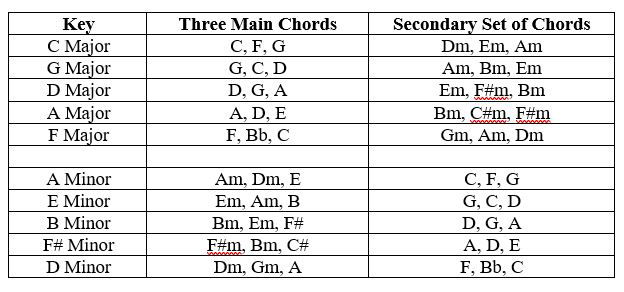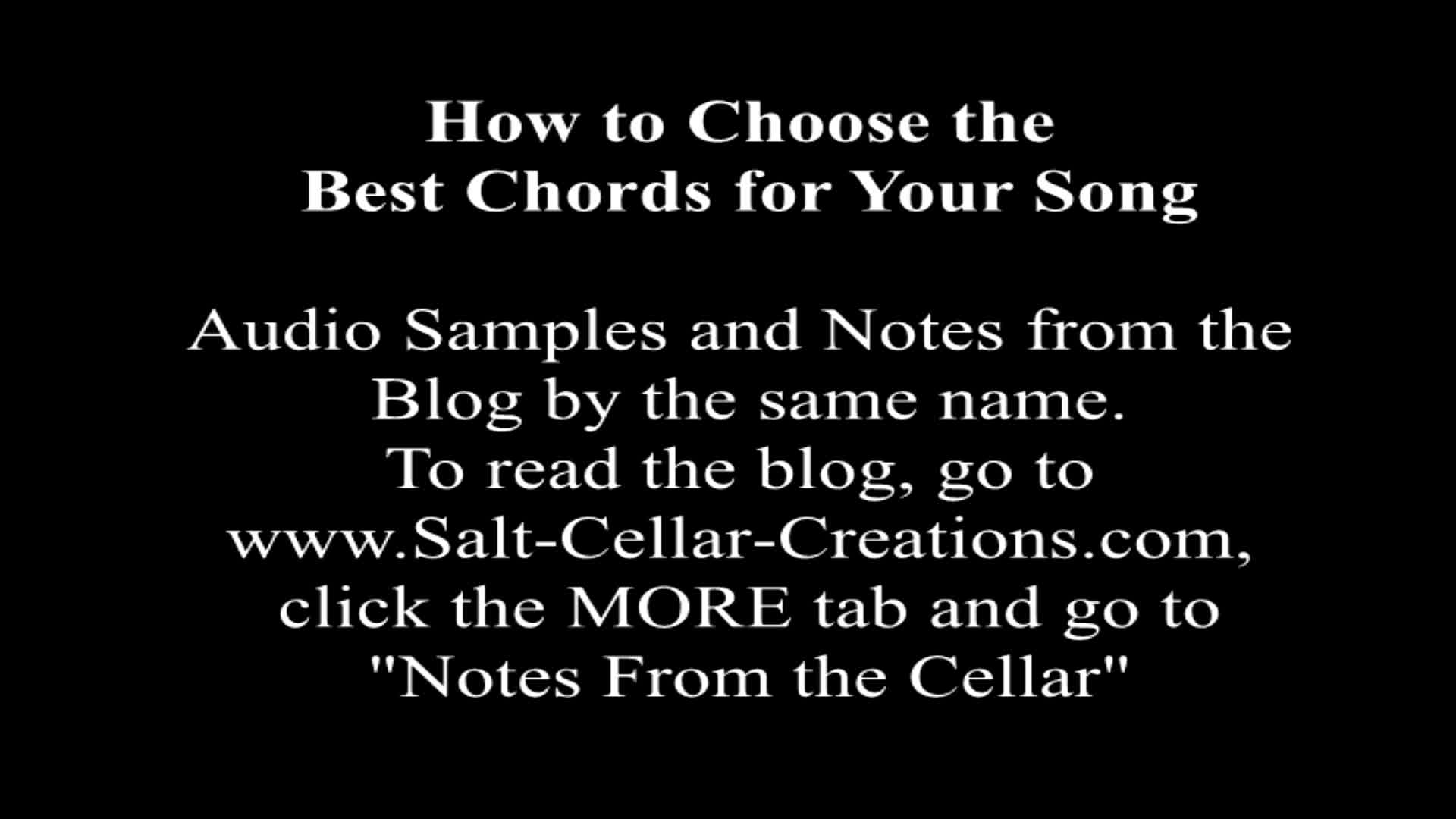How to Choose the Best Chords for Your Song

Until the 17th century, the idea of music chords didn’t exist. During that time, there was a lot of great music being produced by people like J.S. Bach and G.F. Handel. However, they didn’t think in terms of chords as we understand them today. Their music was an evolution from the days of polyphony, different melodies being played or sung at the same time. During that time, some music theorists tried to understand what made this music so wondrous to hear. That’s when they discovered the stacking of three or more notes that made a chord.
This article deals with choosing chords for a song, more likely a piece of music with lyrics. Some people are looking for a chord progression for a new one. Some are simply trying to find just the right chord for a particular place in a song. And others are looking for alternate chords for an arrangement of a song.
Before we discuss a good process for choosing the best chords for a piece of music, let’s first review some basic music theory. The examples will be in the key of C because there aren’t any sharps or flats unless there are accidentals. Remember that chords are always indicated by capital letters and notes by lower case. (And, in this article, chords are in Bold as well).
Basic Scale and Chords – Here are a few things that you need to know as reference so you can understand the examples.
- A C major scale has eight notes, c d e f g a b c. Each note has a corresponding number. c-1, d-2, e-3, etc. Chords have three or more notes. If there are only two notes, it’s an interval, not a chord.
- A C major chord is made of c, e and g - 1, 3, and 5. Here’s where it could become confusing. When speaking of the notes in the scale, musicians will call them by number. However, when speaking of the notes in a chord, they will call them by the numbers related to the chord, not the scale of the key in which the song is written.
- An F major chord is f, a and c. That is the 4, 6 and 8 of the scale, but 1, 3, and 5 of the chord. The f note is the 1, the a is the 3 and the c is the 5.
- A G major chord is g, b and d. That is the 5, 7 and 9 of the scale (it’s possible to count higher than eight when necessary), but 1, 3 and 5 of the chord. Among the three chords, all the notes in the scale are used.
- When musicians discuss possible chords when collaborating on a song, they may say that they want to flatten the third of an A chord, for example. The song could be in any key, but the notes in the chord are identifiable by the numbers that correspond to that chord.
- For each major chord, there is a minor chord that goes with it. It’s called a relative chord. The relative minor to C major is A minor – a, c and e. The relative minor to F is Dm – d, f and a. And the relative minor to G is Em – e, g and b.
Here’s a little chart to help lay it all out. Each dot indicates which notes are in the listed chords. They’re not all in root position, that is the first note in the chart isn’t always the name of the chord, e.g., the G chord should read g, b, d , but it starts with the d in the chart. Chords are always indicated by capital letters and notes by lower case.

Most Common Chords – For any major or minor key, there are three main chords that work well in that key, as well as a secondary set of three chords.
- Primary Set – The three chords in the primary set are always the 1, 4 and 5. In major keys, they are all major chords. In minor keys, the 1 and 4 are minor and the 5 is major.
- Secondary Set – The secondary set is different for major and minor keys. In major keys, the secondary set is the 2, 3 and 6 chords, all minor. For minor keys, the secondary set is the 3, 6 and 7 chords; these are all major chords. Minor keys are often treated as modes and, although the 6 and 7 secondary chords might work in a major key, they are more likely to occur in a minor key.
Here’s a little chart with some of the more popular keys for guitar and other music that show what the chords are that usually go with that key. The first five major keys correspond to the second five as relative minor. That is, they would have the same key signature, but start and end (usually) on a different chord.

We haven’t even touched on some alternate forms of chords, things like suspensions (of which there are three), sevenths (which add extra motion to the end of a phrase), add-on notes like Dadd2, or alternate noted for the bass part. These would be part of any additional study of music theory.
Choosing Chords - So, now we’ve got some basic chords to work with. Let’s see if we can find the “right” chords to use to make a great song. We’re in the key of C, so we’ll use the chords from the chart above.
Below are three examples of how you might use chords in this simple melody. The notes names are underneath the notes in the first example. The melody will never change but the chords will. You can hear these samples in the video below. (You can watch the video, read the text or both. The text has a little more information.)
The first set of chords is basic. There is one chord in each of the first and second measures, a split bar in the third and one chord for the fourth. For each of the chords, most of the notes in the melody are part of the chord. It had four basic chords, C, F, G and C. In the third measure, the G chord also includes the e note which would not be considered dissonant since it’s a passing tone.

This next set contains a popular progression (1-5-6-4) and ends with a full cadence, including the dominant seven (G7).

There are probably a dozen different chord progressions that would work for this melody, some better than others. And some would have a different “flavor” than others, so it might depend on how you wanted to flavor the music. This last one would work for a more skilled guitarist, but remember, not all music is made for guitar! And we limited ourselves to the few chords in the chart. The are other chords, like A-flat, Fm and D half-diminished that would bring even more color to the music.

Let’s analyze this last example (above). Notice that the notes in the song determine which chords to use. The first two e’s are in the C chord. The third e is what could be called a passing tone to the f in the F chord. Similarly, the e and f together could spell an Fmaj7 chord, which is what I used there because it has more color. Notice that it’s not over-used. The g is solidly in the G chord. The c is in all three chords - C, Am and F. The only other passing tone is in the Dm chord. That half-step, as a passing tone, offers just enough color, like a dash of paprika. You can see how the rest of the notes fit the chords.
Tempo Can Affect Chord Choice – Very simply stated, a slower song can have a few more chord changes than a faster one. This is not always the case, but it’s a good general rule.
If a slow song doesn’t change chords, even if it’s just a variation on a chord, e.g., D, Dsus4, D, it can lose momentum quickly. There are a number of instances where this is the goal, but, unless it is, the song needs a little movement.
Likewise, if a faster song has too many chord changes, especially if it has a rapid-fire melody, it can sound confused and unintelligible. Again, there may be a reason to use that for effect, but it would be good to use it for only a part of the song.
First Steps in Application:
- Write down, find out, figure out or have someone else figure out what the notes in your song are. That is, write it down in real notes, not tabs or chord chart. (I can do that for you at a reasonable cost. Look under Music Services for Transcribing.)
- Decide what flavor you want. This may not be as easy as choosing chocolate, vanilla or strawberry. Do you want a common pop sound, something more rock-ish, or maybe something more like world music or even something classical or like a hymn?
- Identify all the chords you know that might go with each note or set of notes. A set of notes typically starts on the main downbeat and/or secondary downbeat of each measure. In 4/4 that would be beats one and three. In 6/8, that would be beats one and four.
- Now start trying chords. There are few ways to do this:
- Just start fiddling. Which ones match and sound good?
- Start with a preconceived or “usual” progression and see if it works and works well. (Now is not the time to make it “good enough”). You may need to adjust it to fit the notes.
- After you’ve studied theory more and done this educated process more, you can start with applying the theory and see how it sounds. I do this a lot and don’t have to do much, if any, adjusting.
- Now, make it real art, instead of “just another song”.
- If you have a melody that repeats not-for-note, use one or more alternate chords to give it a different feel.
- Also, you might want to change the last note or two of a note-for-note melody to give it some motion.
Final Thoughts:
- This is just the starter lesson. For more information about chord usage, it will be imperative that you learn more music theory. Please find an institution or teacher that has proper credentials. There are far too many places on the internet that claim to know music theory, but which are severely lacking in one or more aspects of it. WARNING: Some music theory may seem to be useless at first, but every bit of it connects to other parts of it, so don’t dismiss any of it or you will miss out on the complete tapestry of musical understanding and appreciation. And please don’t limit yourself to learning only about chord structure. There is more to music than chords, words and melody.
- Remember, real art has beauty AND power, conflict and resolution, high points and low points. Great words and melody are only a part of a great song. If the chords just “lie there”, no one will notice the rest of it. Make it a real work of art!
Salt Cellar Creations understands the beauty and power in music that choosing the right chords can convey. We have the knowledge and skill to properly choose and use appropriate chords. We have a growing library of original works and arrangements that demonstrate those skills and many more. Find out more about what Salt Cellar Creations has to offer HERE.
SCC can also compose an original piece for you or do a custom arrangement for you. There are two ways that this can be done; one is much more affordable than the other. And SCC is always looking for ideas of pieces to arrange or suggestions for original pieces.
We have sold music not only in the US but in Canada, the United Kingdom, France, Australia, New Zealand and Austria. Please visit the WEBSITE or CONTACT US to let us know what we can do for you!
